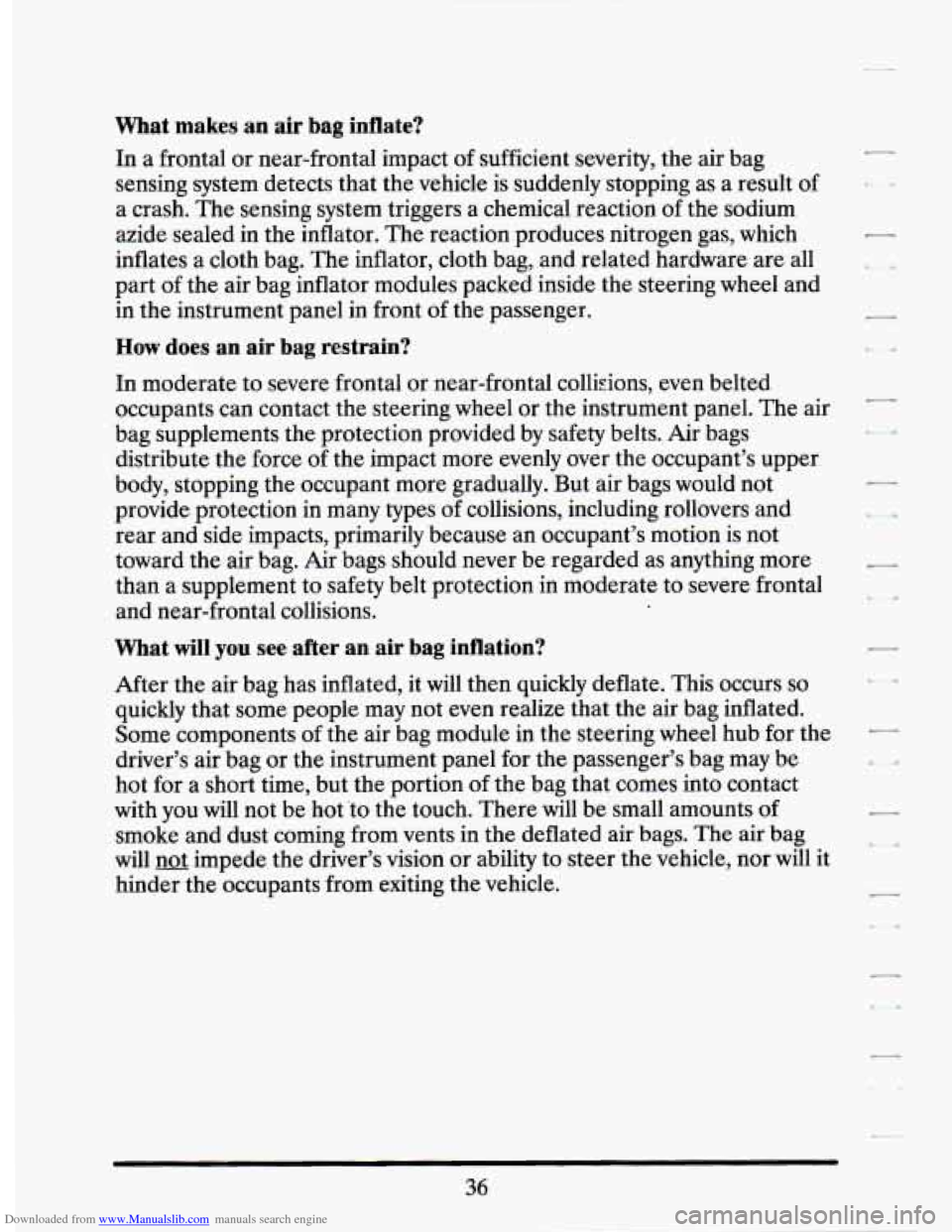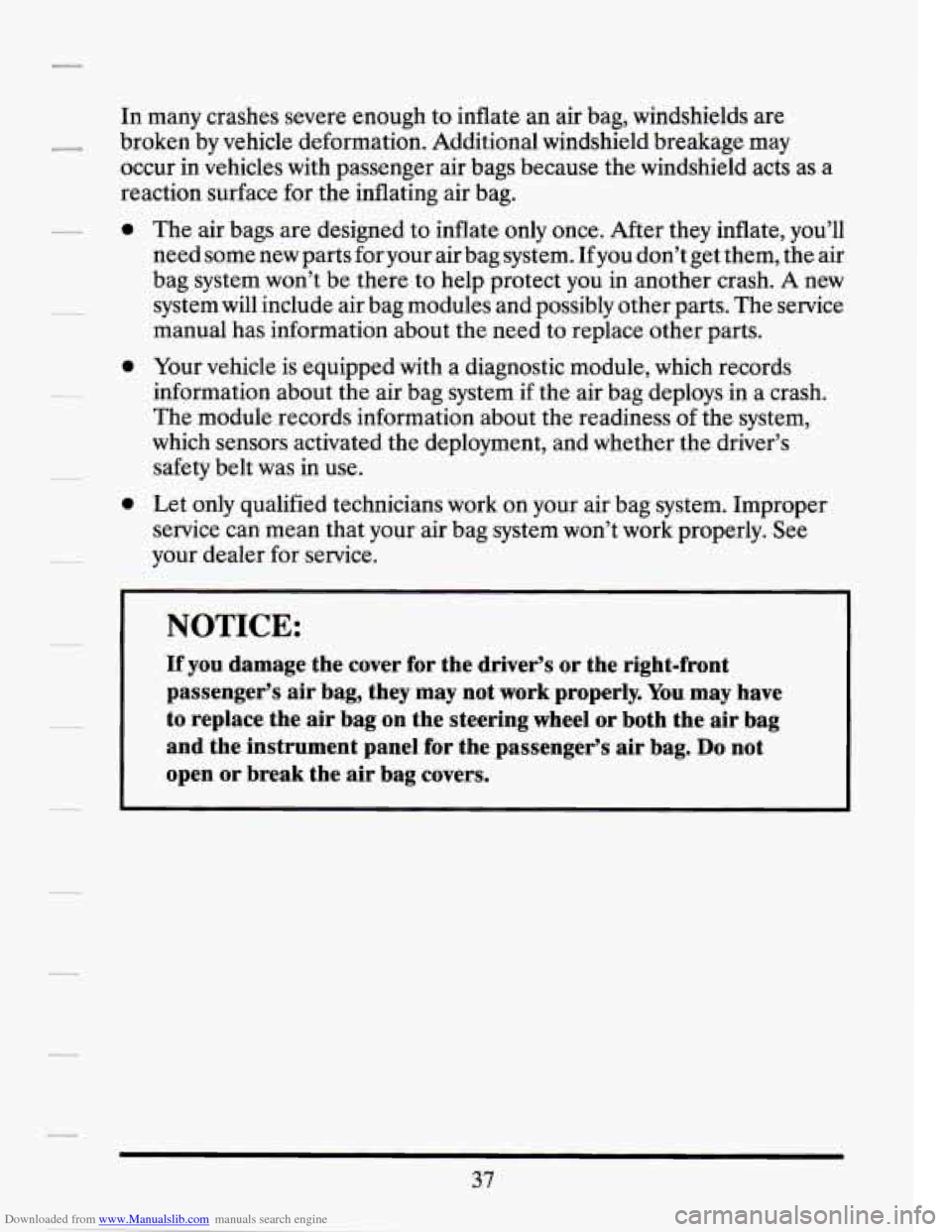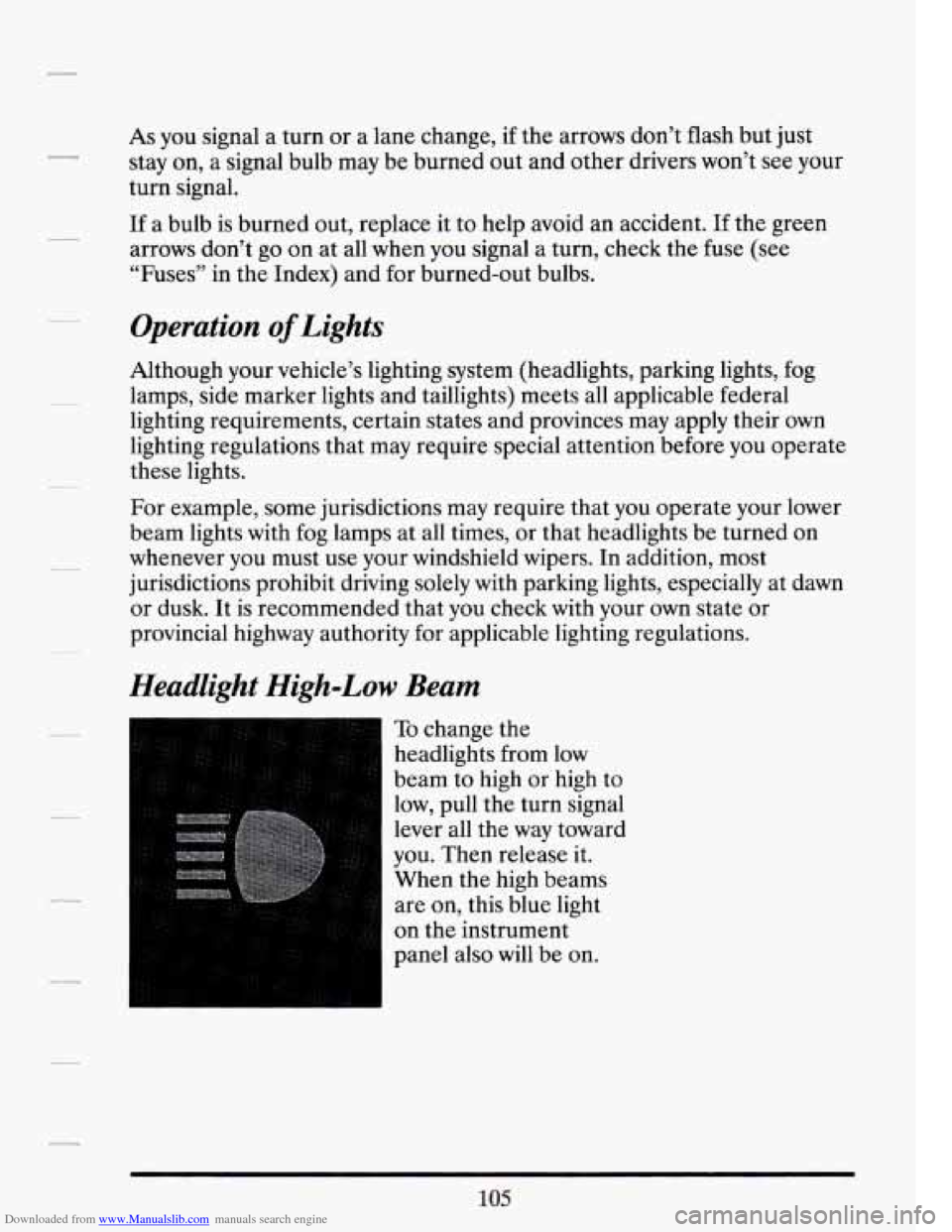Page 29 of 399
Downloaded from www.Manualslib.com manuals search engine The person keeps going until stopped
by something.
In
a real vehicle, it
could be the
windshield
...
or the instrument
panel
... c-
Page 46 of 399
Downloaded from www.Manualslib.com manuals search engine Air Bag Readiness Light
There is an air bag readiness light on the instrument panel, which has
“INFL REST.” or “INFLATABLE RESTRAINT” on it. The system
checks for electrical malfunctions, and the light tells you
if there is a
problem.
INFLATABLE
RESTRAINT
You will see this light
flash for a
few
seconds when you
turn your ignition to
“Run” or “Start.”
Then the light should
go out, which means
the system is ready.
Remember,
if the air bag readiness light doesn’t come on when you start
your vehicle, or stays on,
or comes on when you are driving, your air bag
system may not work properly. Have your vehicle serviced right away.
.-
33
Page 47 of 399
Downloaded from www.Manualslib.com manuals search engine How The Air Bag System Works
I
Where is the air bag?
The driver’s air bag is in the middle of the steering wheel. The right-front
passenger’s air bag
is located in the instrument panel on the passenger’s side.
34
L
Page 49 of 399

Downloaded from www.Manualslib.com manuals search engine What makes an air bag inflate?
In a frontal or near-frontal impact of sufficient severity, the air bag
sensing system detects that the vehicle is suddenly stopping as a result
of
a crash. The sensing system triggers a chemical reaction of the sodium
azide sealed in the inflator. The reaction produces nitrogen gas, which
inflates a cloth bag. The inflator, cloth bag, and related hardware are all
part
of the air bag inflator modules packed inside the steering wheel and
in the instrument panel in front
of the passenger.
How does an air bag restrain?
In moderate to severe frontal or near-frontal collieions, even belted
occupants can contact the steering wheel or the instrument panel. The air
bag supplements the protection provided by safety belts. Air bags
distribute the force of the impact more evenly over the occupant’s upper
body, stopping the occupant more gradually. But air bags would not
provide protection in many types of collisions, including rollovers and
rear and side impacts, primarily because an occupant’s motion is not
toward the air bag. Air bags should never be regarded as anything more
than a supplement to safety belt protection in moderate to severe frontal
and near-frontal collisions.
What will you see after an air bag inflation?
After the air bag has inflated, it will then quickly deflate. This occurs so
quickly that some people may not even realize that the air bag inflated.
Some components of the air bag module in the steering wheel hub for the
driver’s air bag or the instrument panel for the passenger’s bag may be
hot for a short time, but the portion of the bag that comes into contact
with you will not be hot
to the touch. There will be small amounts of
smoke and dust coming from vents in the deflated air bags. The air bag
will
not impede the driver’s vision or ability to steer the vehicle, nor will it
hinder the occupants from exiting the vehicle.
36
Page 50 of 399

Downloaded from www.Manualslib.com manuals search engine In many crashes severe enough to inflate an air bag, windshields are
broken by vehicle deformation. Additional windshield breakage may
occur in vehicles with passenger air bags because the windshield acts as a
reaction surface for the inflating air bag.
0
0
0
The air bags are designed to inflate only once. After they inflate, you’ll
need some new parts for your air bag system. If you don’t get them, the air
bag system won’t be there to help protect you in another crash.
A new
system will include air bag modules and possibly other parts. The service
manual has information about the need to replace other parts.
Your vehicle is equipped with a diagnostic module, which records
information about the air bag system if the air bag deploys in a crash.
The module records information about the readiness
of the system,
which sensors activated the deployment, and whether the driver’s
safety belt was in use.
Let only qualified technicians work on your air bag system. Improper
service can mean that your air bag system won’t work properly. See
your dealer for service.
NOTICE:
If you damage the cover for the driver’s or the right-front
passenger’s air bag, they may not work properly.
You may have
to replace the air bag on the steering wheel or both the air bag
and the instrument panel for the passenger‘s air bag.
Do not
open or break the air bag covers.
37
Page 78 of 399
Downloaded from www.Manualslib.com manuals search engine = 1
FEATURES AND CONTROLS
Here you can learn about the many standard and optional features on
your Cadillac, and information on starting, shifting and braking\
.
Also
explained are the instrument panel and the warning systems that\
tell you
if everything is working properly -- and what to do if you have a problem.
KEYS
65
Page 117 of 399
Downloaded from www.Manualslib.com manuals search engine Turn Signal and Lane Change Indicator
To signal a turn, move
the lever all the way up
or down. When the
turn is finished, the
lever will return
automatically.
To signal a lane
change, slightly move
the lever up or down.
When the lane change
is finished, release the
lever.
1 A green arrow on the
instrument panel will
flash in the direction of
the turn or lane
I change.
-
L.. -4
If for some reason your turn signal is left on, the Driver Information
Center will display
“TURN SIGNAL ON” (after driving about a mile) to
remind you to turn it off.
Page 118 of 399

Downloaded from www.Manualslib.com manuals search engine As you signal a turn or a lane change, if the arrows don’t flash but just
stay on, a signal bulb may be burned out and other drivers won’t see your
turn signal.
If a bulb is burned out, replace it to help avoid an accident. If the green
arrows don’t go on at all when you signal
a turn, check the fuse (see
“Fuses” in the Index) and for burned-out bulbs.
Operation of Lights
Although your vehicle’s lighting system (headlights, parking lights, fog
lamps, side marker lights and taillights) meets all applicable federal
lighting requirements, certain states and provinces may apply their own
lighting regulations that may require special attention before you operate
these lights.
For example, some jurisdictions may require that you operate your lower
beam lights with fog lamps at all times, or that headlights be turned on
whenever you must use your windshield wipers. In addition, most
jurisdictions prohibit driving solely with parking lights, especially at dawn
or dusk. It is recommended that you check with your own state or
provincial highway authority for applicable lighting regulations.
Yeadlight High-Low Beam
To change the
headlights from low
beam to high or high to
low, pull the turn signal
lever all the way toward
you. Then release
it.
When the high beams
are on, this blue light
on the instrument
panel also
will be on.
105